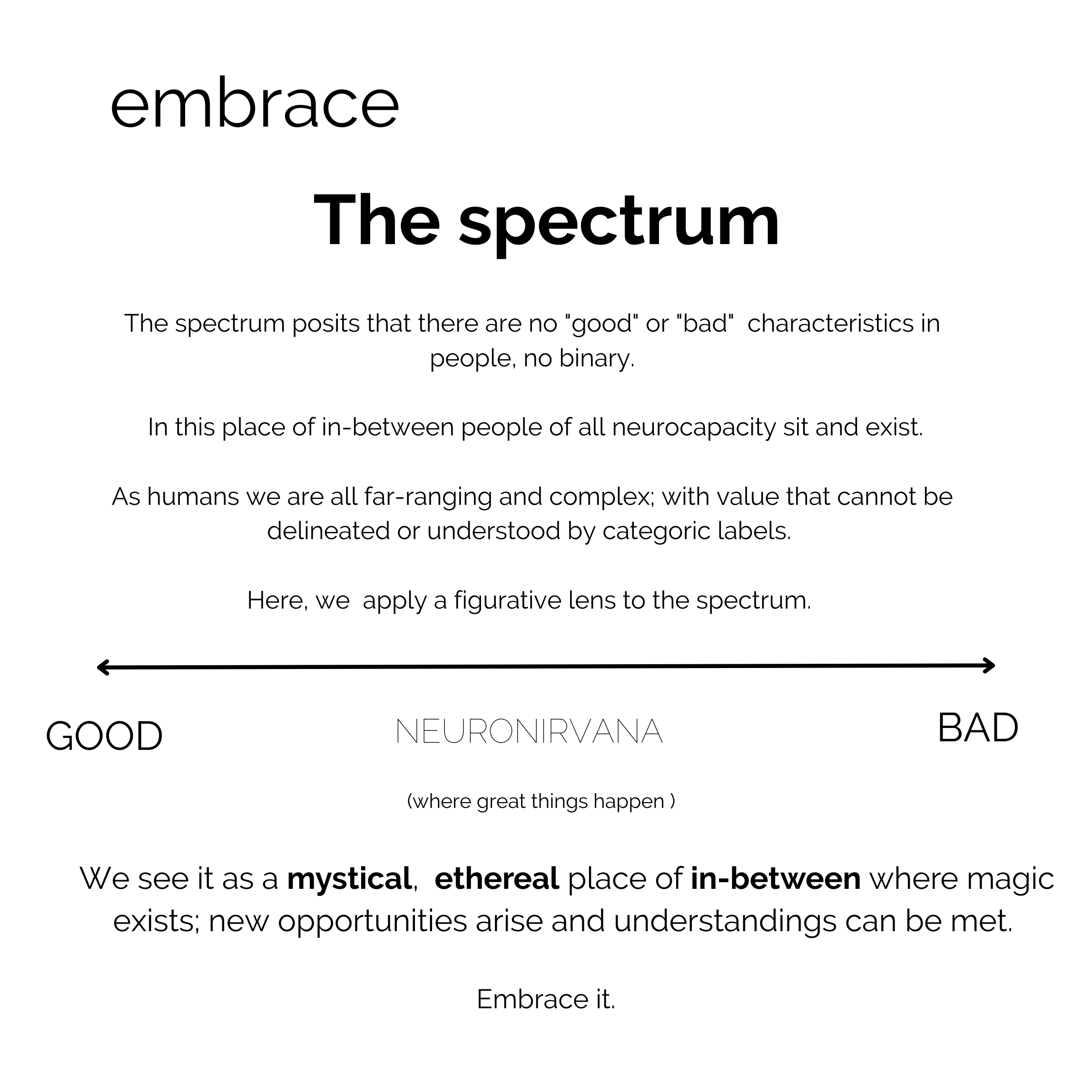
Supporting Neurodiversity in the Workplace (Part 2)
Last week, I introduced you to the term “neurodiversity”; I discussed what it is, why it matters and of course, I introduced you to the spectrum.
That elusive, ethereal, and mystical place where we all sit. Where this article begins.
I hope you enjoyed the brief interlude and found some value in learning these terms. If you’re still a little confused and feel a lot of what I’ve spoken about is mindless prattle, fret not, for this week we are going to turn the intangible into clear methods, tactics and action.
Now, let us return back to that place, the spectrum.

Begin by taking the deepest breath you’ve taken all day (Go on, do it).
Close your eyes for a moment and remember the spectrum.
Reflect on the past week, did you find yourself creating any links to the spectrum and your own real-life Maybe at odd moments you found yourself thinking back to the spectrum, seeing some vague relevance, yet not clearly able to articulate why or what it meant.
Maybe at odd moments you found yourself thinking back to the spectrum, seeing some vague relevance, yet not clearly able to articulate why or how to do it.
What does it look like? What does it feel like?
Do any examples come to mind?
Embracing the spectrum.
- Embrace the spectrum on how you think
- Embrace the spectrum in how you act/ speak
Embrace the spectrum in how you think
It may sound like a bunch of whimsical pablum to you, (that lacks the rhetoric ring of KPI, out-of-the-box, low-hanging-fruit) but that’s exactly the point. Change is supposed to feel different; it’s supposed to sound different and, (quietly) do you yourself even understand that corporate jargon that rolls so easily off the tongue.
As aforementioned, embracing neurodiversity must begin with an embrace of the spectrum; in how we think and speak and act.
In our realm, conditioned to view things in binary it can be challenging at first to apply a more lateral lens, but tapping into this space of in-between can give rise to more unforeseen opportunities.
You’ll recall last week; I listed a set of qualities typically seen amongst neurodiverse individuals.
- High impulsivity
- Difficulty concentrating
- Low social ability
- Sensory sensitivity
As a manager, it can be harrowing to first come across employees that exhibit these sorts of qualities. In embracing the spectrum, we recognise you cannot view things as either “good” or “bad”, that doing this is reductive and rather seek to reframe the way we think of them.
- High impulsivity can also be good decision making
- Difficulty concentrating can also be ability to manage multiple tasks at once
- Low social ability can also be hyper focus
- Sensory sensitivity can also be high attention to detail.
Better?
Often our first reaction on hearing or seeing something is to evaluate, dissect or classify it as “good” or “bad”. By embracing the spectrum in how we think and act, we embrace the notion that inherent value exists in everything and amend this simplistic method of thinking.
Embrace the spectrum in how you speak/ act
Of course, thought is redundant without decisive action.
In my own research, I noticed it was indeed startling to read many articles that recognised neurodiversity (scoring big points) but failed to amend the language or way they approached these topics. Embracing the spectrum will require more than thought but a complete restructuring of our own lexicon; particularly with how we speak about and label those around us. Merely throwing the word around to feign some understanding won’t do much.
I came across titles like;
- Neurodiversity as a competitive advantage
- Tap into neurodiversity for more profit
- Benefits of embracing neurodiversity in the workplace
Indeed, this in itself signals the need for a shift in the way we think, view, and speak about neurodiversity. I posit, embracing neurodiversity requires a shift away from these terms, instead recognising that employers are nuanced and multifaceted.
It still all sounds a little vague, doesn’t it? I admit, even I find it difficult at times to grasp what is truly.
Although articles like this may appear well-intentioned and are good at stimulating the conversation, viewing employers through this narrow lens; categorising their value through benefit and success metrics is counterproductive to the very notion of diversity and can be demoralising.
Of course, it still all sounds a little vague, doesn’t it? I admit, even I myself find it difficult at times to grasp this notion.
Although, it can be dangerous to reduce such a complex and diversified topic into a few numbered tactics, I did promise some form of an answer.
I have distilled all my research into two easy to manage maxims that will act as your sword and shield to accompany you as you enter the vast and uncharted realm of the spectrum.
Maxims to work by
- Know thy employee
- Be accommodating to all
Know the employee
How well do you know your employee? Really? Do you know them beyond the usual mechanistic office chat, the back and forth of emails?
How do they like to work?
Where do they operate best?
All necessary questions to consider. (Remember, the “spectrum”). Before seeking employers or reeling out a list of other prominent companies who have reformed their HR processes to access neurodiverse “talent:”, I propose to speak with your own employees first.
To leverage the talent of your employee, we must exercise greater sensitivity to the individual needs. In short, get to know the person better, so you can manage them better.
We must accept that its very likely that we have neurodiverse individuals within our workplace. In fact, according to statistics 30- 40% of the population classified “neurodiverse”. As such there’s a high probability that employees within your own workplace may themselves be categorised neurodiverse.
Consider the possibility too that there may be neurodiverse individuals already in your workplace and seek to create an environment that is more conclusive and conductive for them.
This can look like:
- Asking your employer how they prefer to operate. Do they need support in some areas/ equipment?
- Creating tailored career paths or plans for individuals
- Hiring more mental health professionals or providing greater support services
- HR to become more accommodating to irregular hours and patterns of work
- Increase job personalisation
- Prioritising employee mental health
- Offering variety settings for employers to work at (embracing non-traditional methods of working)
- Allowing employers more autonomy and control of their schedule
- Operating more direct or simple approach of corporate communication
- Experimenting with different methods of corporate communication (outside of email, traditional meeting structure..etc)
- Offer new roles in the capacity of mentors
Be accommodating to all
Next, be open to amending the way you recruit and interview your employees.
The typical methods of recruitment that we ascribe to in the corporate structure are likely to be inhibiting you from including neurodiverse individuals within your workplace, perhaps try tweaking the process to be more accommodating?
Becoming more accommodating can look like…
- Change interview process and approach to better support and be inclusive to neurodivergent applicants
- Allow applicants to have their own support in the process
- Allow applicants to dictate how they would like to be interviewed
- Offer various other approaches to interview and application outside of traditional forms (non-tangible forms)
- Create a specific set of questions that actively acknowledge neurodiversity and methods of working
- Employ and consider applying appropriate HR software that actively considers this
- Offer trial or work shifts to allow people to see if they are suited to the role
- Amend and offer a structured HR program to support
Final thoughts
Clearly, there is no single panacea, no hard and fast rule to fostering and supporting neurodiversity in your workplace. As a concept itself it is fluid and flexible. In fact, to offer you a neat list of tactics would itself paradoxical to the very notion of “diversity”.
Rather than seeking out specific answer or tackling one single approach, I suggest it begins with a dismantling of our own mental scaffolding. You’ll find being more yielding to this individualised approach of support in workplace might provide more internal solace and overall satisfaction amongst workers.
In embracing the spectrum, we also allow new ideas to flourish and unforeseen opportunities to bloom. In becoming a more “neurologically supportive workplace” we recognise no single human can be defined or understood in one way.
Expanding out from our own corporate-cosm, we see there is great value in celebrating and recognising the nuanced and idiosyncratic nature of humans; in how we think, process and analyse information and communicate.
We are all inherently complex and ever changing, far too faceted be understood within the finite window of 9-5.
If you find yourself in doubt on where to begin, referring back to the “spectrum” can be a great way forward; start by simply viewing all your employees, or people in your own life as operating or existing on a spectrum that will warrant an individualised response.
Make room for the nuance.
Embrace the spectrum.
